 |
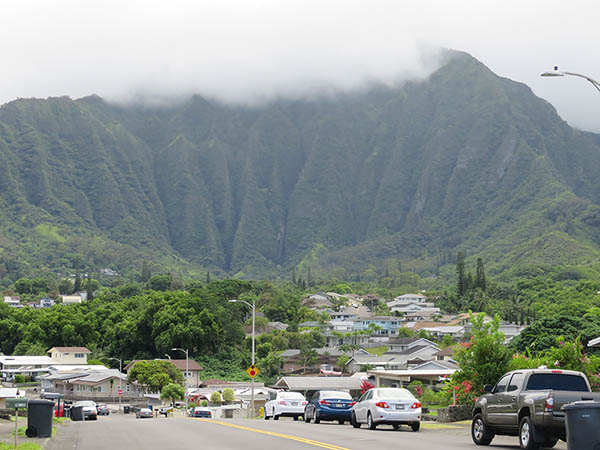
Post-war suburban growth below ‘Ioleka‘a.
“World War II affected how the farmers grew everything,” Kanekoa says. “Their sons went to war, came back, had access to the GI Bill, had access to college. So you see some families moving out. Then Kamehameha School changed their policies. They started to look at this land as potential to develop for housing, and then the whole shift for land development occurred.

Harold Castle's house on Mōkapu, from the top of Heleloa Dune. Photo from Mōkapu: Paradise on the Penninsula.
“We know that about a third of this land was held by kuleana landowners—this area of Hoi, just Hoi alone. A lot of the kuleana landowners got together and created He‘eia Agriculture Company to create better agricultural. Kāne‘ohe Ranch, which is now Harold K. L. Castle Foundation, they did a lot of land deals here that weren’t always great. It just happened that He‘eia Agriculture Company went bankrupt in 1924, 1926.
"Kāne‘ohe Ranch purchased all of the lands and then sold the lands directly to Kamehameha Schools right after that. It was interesting that they went bankrupt and Castle bought it, and then gave it right to Kamehameha School or sold it to Kamehameha School [KS]. And then Kamehameha Schools [KS] owned entirely 100% of the land.
“It was always owned by partially KS, but a lot of families had lands here. And so, we always realize that these lands weren’t just Pauahi’s lands. There are a lot of families had kuleana lands in here. A lot of them were the original kuleana families. And they purchased other kuleana lands. The land titles were already getting swapped and purchased at that time.
“After Statehood, a lot of foreigners came with money,” Lilikalā explains. “There were only about 300,000 people living in Hawai‘i in statehood time. I think it was right about the same time in the ‘50s that Mōkapu got taken over by the military and there were a lot of houses out there before. Not kuleana lands. There were some kuleana lands, but there were also people who bought land there, from the government. That was all taken over by the military. That brought in a different type of people into this area.
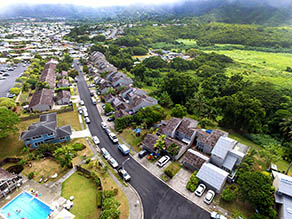
The Ali‘i Cluster subdivision, alongside the wetlands of Hoi, and suburban development reaching towards Windward Mall.
“This whole area used to be cow pasture, there were these townhouses where I live now were, and the housing developments between here and Windward Mall, that was all cow pasture when I was a child. We used to drive along the old road to get to Kahana. So we went to school in Kāne‘ohe, my mother worked in Kāne‘ohe, and then we would drive home to Kahana on the old road. It’s kind of how we went back and forth.
“I always remember the mangrove trees by the long bridge, but the rest of it was cow pasture and then they started building houses in this area, and I thought rich people bought them. Actually, where we lived in Kahana was kind of a shack. Every time it rained, we had to put out a pot for every part of the house because the roof leaked. There was an outside toilet. We didn’t have hot water. Lucky we had any running water.
“So, these kind of townhouses, wow. They are just like mansions to me, and my whole goal in life was to live in a townhouse. I’m so happy I’m living in a townhouse! I also like that we’re at the top of the hill because we’re used to living in Ka‘a‘awa, we’re at the bottom of the hill, and every time it rained heavily, all the water would come and we would flood. It’s nice to be in a place that doesn’t flood, knock on wood.
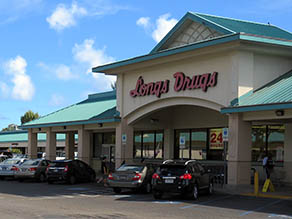
Longs Drugs at the Kāne‘ohe Bay Shopping Center, across from Windward Mall.
“Still today, a lot of Hawaiians live here,” Lilikalā says. “You go to Longs, or Safeway, or anywhere, you’re standing in line, it’s mostly Hawaiians standing in line around you. So I really like living here, because I like living with Hawaiians. For instance, one time there was a hurricane coming. Everybody was worried, so we all went to go get water, we went to go buy tape to tape up our windows. It’s the first time we’re really going to have a hurricane maybe coming to O‘ahu.
“I’m standing in line with the kids, and my ex is off somewhere—out of town, maybe in another country. I was really worried about this hurricane, and everybody was making sure that there was enough for the next person. Nobody was hoarding all of the tape, all of the water. ‘Sister, you sure you got enough water for your kids? You got enough this and that? What about peanut butter?’ We’re standing in line and people are taking care of each other in line. That’s Kāne‘ohe. That’s He‘eia. It’s really very nice.
“Even when you’re driving down the road and you want to get into the next lane, you just got to pause, you put on your blinker, and they stop and they let you get in the lane. There’s nobody trying to road rage. Everybody is like, ‘Oh, yes. Just move over. It’s okay.’ And I love living here. Plus, it’s close enough to town.
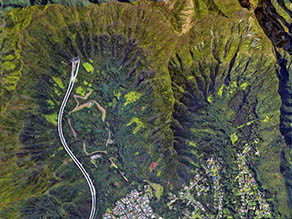
Aerial view of the upper-valley areas, above the private property of the suburbs.
“48% of Hawaiians now have left Hawai‘i because we can’t afford to live here. We need land. So what I’d like to see, I want to see land for Hawaiians as a homeland in each one of the 1,600 ahupua‘a. From top of the the mountain down to where private ownership begins, so it’s all the mauka lands. I would say to private land owners, ‘If you’re lucky enough to own land in Hawai‘i, that’s not the land we want.’ We don’t want to fight with people who have private ownership.’ We want state land. We want federal land. We want that land back. We want a homeland for the Hawaiian people. If the Israelis can have a homeland for the Israelites, the Hawaiians can have a homeland for the Hawaiians.
“It should not be that 48% of us have to move away because we can’t afford to live here. I want to plant food in that land. I want to build housing on that land. The housing should be built closest to where the electric and the water lines end so we can just add onto it. I want us to grow our own materials to make our own housing. I don’t want any housing more than 500 dollars a month, because right now, you’re lucky if you can get a studio for $1,500 a month here in Hawai‘i on O‘ahu. Houses are going for 1 million dollars. It’s ridiculous.
“I have all these cousins who are moving away every week. Somebody else moves away, usually Vegas, or maybe Washington, or Arizona, and they all want to move home but can’t afford to do so. So I want land for food and housing for Hawaiians. That’s what I want.
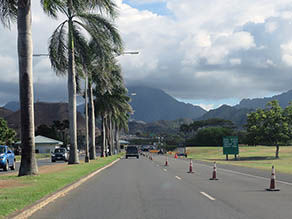
On the Marine Corps Air Base.
“We’d like to have the Marine Corps Air Station closed down and I’d like to live there! Look at all the housing you can provide for Hawaiians. One-third of all the homeless are Hawaiian. One-third. We wanted Bellows Field [In Waimānalo] back because Bellows is 1,300 acres of Hawaiian homelands. And the guy who was running Mōkapu Marine Corps Air Station said they need Bellows to practice amphibious landing. So, if they give up Bellows, they’d have to give up Mōkapu. We said, ‘Okay, good. See California? Lots of amphibious landing spaces. Aloha.’
“But it’s no use for us to talk about having land, running land, if we don’t have a plan. My job in Hawaiian Studies is to make sure that our young people are formulating plans. And if you look at He‘eia, those folks who are up in Waipao—Kapalikū Sherman—they are graduates from the Kamakakūokalani Center for Hawaiian Studies. The people who made Paepae o He‘eia, the fish pond, they come from Hawaiian Studies. They have Hawaiian Studies graduates teaching in Kamakau School.
“So, all the way through the ahupua‘a, we see how the study of Hawaiian ancestral knowledge has empowered their identity and allowed them to make peaceful change to feed everybody. No Hawaiian ever says, ‘You’re not a Hawaiian. We’re not going to feed you.’ We feed everybody. We make food for everybody. I think that’s the way to proceed.”
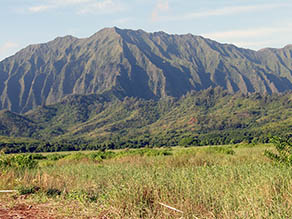
The lands of Hoi.
“The shifting land use over time has removed people very much from where they belong or where they were,” Kanekoa says. “They can stay disenfranchised and detached, and therefore it doesn’t hurt as much. Maybe that was a protective mechanism by our families to protect us from the generational trauma. But now, we’re trying to open that up so that kids and families can reattach themselves to land.
“And that comes with issues, right? Because once you feel you’re tied to land, then you start to really care for it and want to fight for it. And if you’re a land manager that wants to do a project, you have all of these additional stakeholders to care for, and take care of, and work with. But for Kako‘o, we want people farming here. So the more problems, the merrier—meaning it’s going to be less chance of it ever being developed.”
“Because these houses are going for over a million each, and you’re sitting on urban land, which this land is. There’s going to be a huge pressure to develop it as land gets more and more scarce on the island of O‘ahu.”
“The lifestyle that we lived, to me, was never respected by people who moved in,” Emalia laments. “There’s a development now coming up where I live, below me, where they’re building twenty two-story townhouses that sell at a beginning price of $1.2 million. Okay, it’s going to kill my real property taxes, but I have to keep my place, so it should bring up the value of my property. But at the same time, you have this intrusion and invasion of a different kind of lifestyle below us.
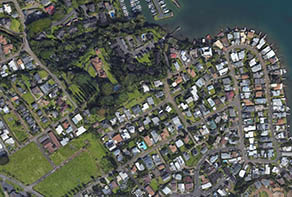
The land from the Protestant church (left, on the green) down past Emalia's place to the shore.
“They’re going to have a problem with the roadway because when my grandfather set up our lots, he also established our own road in case the owner of the adjacent road closed off access to us, we’d have our own road. That road is needed by the developer so that he can access all of his 40-plus people, and so they’re thinking of maybe coming to condemn a portion of my roadway in order to accommodate his road. They want to do it in exchange for them building a road that I can ride on and
"I’m saying, ‘Wait a minute, you don’t get anything for free these days, especially with ‘āina. It’s different here in Hawai‘i.’ We haven’t heard from them in over a year but I’m sure we will hear from them, because they’re almost nearly finished building these condominiums. It’s right on the bluff of the bay and my mother used to tell us ‘You know those poor people, they’re building right on the edge of the water, right on the edge. You know one day all that going down in water.’
“There’s one house that sits at the very pinnacle of the mauna, of that pu‘u and I don’t know, someday there may be a big wind that comes and knocks them off. Somebody said to me, ‘How come they have to build their house that high up?’ I said, ‘Well because they have to be above everybody else, that’s why.’ ‘Oh you mean...?’ I said ‘But where else you want to go after that?’ And how different is the view up there from where below, same view.
“So anyway, we love our ‘āina, we know we have to take care. We know that’s what would be expected of us because that’s how we were raised; besides which, this is where we were born and reared. It’s all part of us.”
|
 |

















